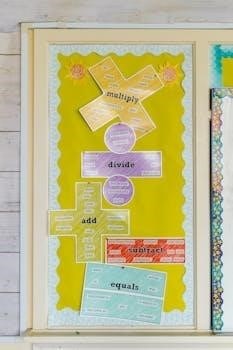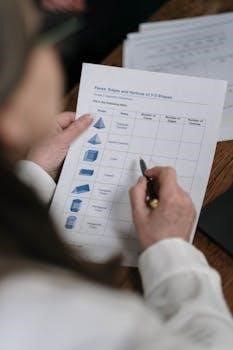Decimal Multiplication Worksheet PDF⁚ An Overview
This section introduces the concept of decimal multiplication worksheets available in PDF format. These resources offer various exercises, including multiplying decimals by whole numbers, decimals by decimals, and powers of ten. They aim to enhance understanding and proficiency in decimal multiplication through practice.
Multiplying Decimals by Whole Numbers

Multiplying decimals by whole numbers is a foundational skill in decimal arithmetic, often introduced as an extension of whole number multiplication. The process is quite similar to multiplying whole numbers, with the key difference being the presence of a decimal point in one of the factors. Initially, students may find it helpful to ignore the decimal point during the multiplication process, treating the decimal number as a whole number. After completing the multiplication, the decimal point is then placed in the product by counting the number of decimal places in the original decimal number and applying that same count to the result. Worksheets often provide a variety of problems with single-digit, double-digit, and triple-digit whole numbers to increase proficiency. These practice exercises commonly involve aligning numbers correctly and carrying over digits as needed, just as with whole number multiplication. Word problems are often included to illustrate real-world applications of this skill. Such problems help solidify understanding by relating abstract calculations to practical contexts. Digital resources and interactive exercises often complement worksheets, providing additional practice and immediate feedback. Students can have fun as they practice with various exercises.
Multiplying Decimals by Decimals
Multiplying decimals by decimals involves an extension of the techniques used for multiplying decimals by whole numbers. The core principle remains the same⁚ perform the multiplication as if the decimal points were not present. However, the placement of the decimal point in the final product becomes more complex. It requires adding up the number of decimal places in both of the original factors. For instance, if one factor has one decimal place and the other has two, the product will have three decimal places. Worksheets often present a variety of problems, starting with simpler scenarios involving tenths and hundredths and progressing to more complex problems with thousandths. These exercises might include aligning numbers vertically, similar to standard multiplication, and also encourage students to estimate the product before calculating, for error checking. Practice problems often include both vertical and horizontal formats. Some worksheets also incorporate visual aids, such as grids, to help students understand the concept of multiplying decimals. Word problems, that place the calculations into real-life situations, are also very useful in making the idea more understandable. Interactive digital exercises can provide an alternative, fun way to practice and receive immediate feedback.
Multiplying Decimals by Powers of Ten
Multiplying decimals by powers of ten, such as 10, 100, 1000, and so on, is a fundamental skill that simplifies calculations and enhances understanding of place value. Instead of performing traditional multiplication, students learn a shortcut⁚ shifting the decimal point to the right by the number of zeros in the power of ten. For example, multiplying by 10 moves the decimal one place to the right, by 100 moves it two places, and so on. Worksheets for this concept usually include a variety of problems, starting with simpler ones that involve shifting the decimal by one or two places, and later involving more complex numbers. These exercises often include both vertical and horizontal formats to give the student a more complete understanding. Some worksheets may incorporate place value charts to visually demonstrate the shifting of digits. Exercises often include problems that involve both whole numbers and decimals, to highlight the similar nature of the method. Some worksheets also include an element of missing numbers. Problems are often presented in the context of conversions between different units of measurement. Interactive digital exercises can provide alternative ways to practice these concepts. Practice involving mental calculations is also useful.
Decimal Multiplication with Models
Visual models provide a concrete way to understand decimal multiplication, especially for learners who benefit from visual aids. Common models include grids, area models, and base-ten blocks, which represent decimals as parts of a whole. Grids, for instance, use a 10×10 grid to represent one whole, where each small square represents one hundredth. To multiply decimals, students shade in the appropriate portions of the grid, and the overlap represents the product. Area models use a similar approach, where the dimensions of a rectangle correspond to the decimal values being multiplied, and the area of the rectangle gives the product. These models help students visualize how decimal multiplication works and make the process less abstract. Worksheets often include partially completed models, where students are required to finish the shading and determine the product. They also provide blank grids for students to draw their own models. The models are very helpful for understanding the distributive property. The use of base-ten blocks is another common method, where whole numbers are represented by cubes and decimals are represented by smaller units. Models are also useful for demonstrating scaling.

Mental Math Strategies for Decimal Multiplication
Developing mental math strategies for decimal multiplication enhances both speed and number sense. One key strategy involves multiplying by powers of ten, such as 10, 100, and 1000, which can be done by simply moving the decimal point to the right. For example, multiplying by 10 shifts the decimal one place to the right, by 100 shifts it two places, and so on. Another strategy is to break down decimals into easier numbers. For example, 0.5 can be thought of as half, and 0.25 as a quarter, which allows for easier calculation. Estimation is also a crucial mental math skill. Rounding decimals to whole numbers or easily multiplied decimals can provide an approximate answer, helping to check if an exact answer is reasonable. Additionally, using the distributive property can be beneficial; for example, multiplying 3.5 by 4 can be approached as (3 * 4) + (0.5 * 4). These mental strategies promote a deeper understanding of decimal multiplication, enabling efficient problem-solving without relying on written calculations. Practice with these mental math techniques builds confidence and facility with decimal operations, making complex calculations less daunting. Worksheets often include exercises specifically designed to enhance these mental strategies.

Column Multiplication of Decimals
Column multiplication of decimals is a structured method for solving multiplication problems involving decimal numbers, particularly when mental math isn’t practical. The process begins by setting up the numbers vertically, aligning them as if they were whole numbers, disregarding the decimal points temporarily. The multiplication is then carried out in the standard way, multiplying each digit of the bottom number by each digit of the top number, carrying over when necessary. Once the multiplication is complete, the decimal points are taken into consideration. The total number of decimal places in both original numbers is counted, and the decimal point is placed in the final product so that it has the same number of decimal places. For instance, if one number has two decimal places and the other has one, the product should have three. This method makes it easier to manage the multiplication process and ensures correct placement of the decimal point. Column multiplication is a reliable technique for handling more complex decimal multiplication problems and provides a clear, step-by-step approach that is easy to follow, especially when working with multiple-digit decimals. Worksheets often provide guided examples and practice problems to help students master this method.
Word Problems Involving Decimal Multiplication
This section focuses on the application of decimal multiplication within real-world contexts through word problems. These problems present scenarios where students must identify the need for multiplication involving decimals to solve a given situation. Word problems are designed to enhance problem-solving skills by requiring students to analyze the problem, extract the relevant numerical information, and determine the appropriate operation to use. For instance, a problem might involve calculating the total cost of multiple items, each priced with a decimal value, or determining the area of a rectangle when its sides are measured in decimal units. These problems challenge students to think critically and apply their understanding of decimal multiplication in practical situations. They help bridge the gap between abstract mathematical concepts and their real-world applications, making the learning process more engaging and relevant. Worksheets often include a variety of word problems with different contexts and complexity levels, which allows students to practice and develop their problem-solving abilities. Such problems are essential in building a strong foundation in mathematics and its everyday uses, while also improving their reading comprehension skills.

Interactive Decimal Multiplication Exercises
This section explores interactive exercises designed to make learning decimal multiplication more engaging and effective. These interactive tools often go beyond traditional worksheets, using digital formats and game-like elements to capture students’ attention. Such exercises may include online quizzes, drag-and-drop activities, and interactive simulations that provide immediate feedback to learners. These dynamic elements allow students to practice decimal multiplication in a fun and stimulating environment, fostering a deeper understanding of the concept. Interactive exercises can also adapt to the student’s skill level, providing personalized learning experiences that cater to individual needs. They often incorporate visual aids and animations that help clarify the process of multiplying decimals, making it easier for students to grasp the underlying principles. For instance, an interactive exercise might use models to visually represent decimal multiplication or provide step-by-step guidance through a challenging problem. These tools support active learning by encouraging students to actively participate in the learning process rather than passively absorbing information. This approach can lead to increased retention and a more positive attitude toward mathematics.
Practice and Review Opportunities
This section highlights the significance of consistent practice and review in mastering decimal multiplication. It emphasizes the availability of various resources that provide ample opportunities for students to reinforce their understanding of this crucial mathematical skill. These opportunities might include a wide range of worksheets, quizzes, and interactive exercises designed to cater to different learning styles and skill levels. Regular practice is key to building fluency and confidence in multiplying decimals. Review exercises often revisit previously learned concepts, ensuring that students retain their knowledge over time. These resources are often structured to allow students to gradually progress from basic multiplication problems to more complex ones, allowing for a steady development of proficiency. Some practice materials may include word problems that challenge students to apply their decimal multiplication skills in real-world contexts, further enhancing their conceptual understanding. Additionally, timed quizzes and review sessions can help students improve their speed and accuracy in performing decimal multiplication. By engaging in frequent practice and review, students can solidify their grasp of decimal multiplication, leading to improved performance in tests and examinations, and a deeper overall appreciation for mathematics.



